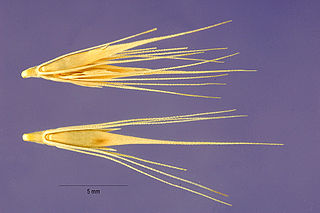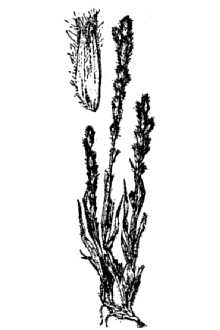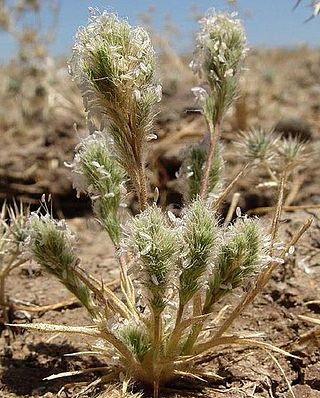
Hordeum is a genus of annual and perennial plants in the grass family. They are native throughout the temperate regions of Africa, Eurasia, and the Americas.

Aegilops is a genus of Eurasian and North American plants in the grass family, Poaceae. They are known generally as goatgrasses. Some species are known as invasive weeds in parts of North America.

Triticeae is a botanical tribe within the subfamily Pooideae of grasses that includes genera with many domesticated species. Major crop genera found in this tribe include wheat, barley, and rye; crops in other genera include some for human consumption, and others used for animal feed or rangeland protection. Among the world's cultivated species, this tribe has some of the most complex genetic histories. An example is bread wheat, which contains the genomes of three species with only one being a wheat Triticum species. Seed storage proteins in the Triticeae are implicated in various food allergies and intolerances.

Hordeum jubatum, with common names foxtail barley, bobtail barley, squirreltail barley, and intermediate barley, is a perennial plant species in the grass family Poaceae. It occurs wild mainly in northern North America and adjacent northeastern Siberia. However, as it escaped often from gardens it can be found worldwide in areas with temperate to warm climates, and is considered a weed in many countries. The species is a polyploid and originated via hybridization of an East Asian Hordeum species with a close but extinct relative of Californian H. brachyantherum. It is grown as an ornamental plant for its attractive inflorescences and when done flowering for its inflorescence.

Hordeum murinum is a species of flowering plant in the grass family Poaceae, commonly known as wall barley or false barley. It is a close relative of cultivated barley.

Hordeum pusillum, also known as little barley, is an annual grass native to most of the United States and southwestern Canada. It arrived via multiple long-distance dispersals of a southern South American species of Hordeum about one million years ago. Its closest relatives are therefore not the other North American taxa like meadow barley or foxtail barley, but rather Hordeum species of the Pampas of central Argentina and Uruguay. It is less closely related to the Old World domesticated barley, from which it diverged about 12 million years ago. It is diploid.

Hordeum brachyantherum, known by the common name meadow barley, is a species of barley. It is native to western North America from Alaska to northern Mexico, coastal areas of easternmost Russia (Kamchatka), and a small area of coastal Newfoundland.

Hordeum depressum is a species of barley known by the common names low barley and dwarf barley. It is native to the western United States from Idaho to California, where it can be found in moist habitats such as vernal pools. This is a small annual grass forming petite patches of thin, hairy leaves and erect stems to half a meter in maximum height. The green or reddish green inflorescence is 2 to 6 centimeters long and about half a centimeter wide. Like other barleys the spikelets come in triplets. There is a large fertile central spikelet about a centimeter long and two smaller, often sterile spikelets on pedicels, each 3 to 5 millimeters long.

Barley, a member of the grass family, is a major cereal grain grown in temperate climates globally. It was one of the first cultivated grains; it was domesticated in the Fertile Crescent around 9000 BC, giving it nonshattering spikelets and making it much easier to harvest. Its use then spread throughout Eurasia by 2000 BC. Barley prefers relatively low temperatures to grow, and well-drained soil. It is relatively tolerant of drought and soil salinity, but is less winter-hardy than wheat or rye.
Agrostis hendersonii is an uncommon species of grass known by the common name Henderson's bent grass. It is native to northern California and Oregon, where it is a rare member of the flora in scattered vernal pool habitats. It is an annual grass ranging in maximum height from 6 to 70 centimeters. It has short, narrow leaves only a few centimeters long. The inflorescence is a dense, narrow, cylindrical tuft no longer than 5 centimeters in length, made up of small spikelets with hairlike tips and bent awns.

Orcuttia californica is a rare species of grass known by the common name California Orcutt grass.
Orcuttia inaequalis is a rare species of grass known by the common name San Joaquin Valley Orcutt grass.

Orcuttia pilosa is a rare species of grass known by the common name hairy Orcutt grass.

Orcuttia viscida is a rare species of grass known by the common name Sacramento Orcutt grass.
Juncus digitatus is a rare species of rush known by the common name finger rush. It is endemic to Shasta County, California, where it is known from only two occurrences near Shingletown. It occurs in spring-moist habitat such as vernal pools in sunny locations in the foothills of the southernmost Cascade Range. The plant was first collected in 1991 and described to science as a new species in 2008.
Poa diaboli is a rare species of grass known by the common name Diablo Canyon bluegrass. It is endemic to San Luis Obispo County, California, where it is known from about five occurrences in the San Luis Mountains near the coast. The type specimen was collected in Montaña de Oro State Park and the grass was described as a new species in 2003. The grass occurs on rugged mountaintops and north-facing slopes in thin soils covering shale rock within a few kilometers of the coastline. Its habitat includes chaparral, oak woodland, coastal sage scrub, and Bishop pine forest.

Hordeum spontaneum, commonly known as wild barley or spontaneous barley, is the wild form of the grass in the family Poaceae that gave rise to the cereal barley. Domestication is thought to have occurred on two occasions, first about ten thousand years ago in the Fertile Crescent and again later, several thousand kilometres further east.

Kesara Margrét Anamthawat-Jónsson is professor of botany and plant genetics at the Faculty of Life and Environmental Sciences, School of Engineering and Natural Sciences, University of Iceland.
Hordeum muticum is a species of wild barley in the grass family Poaceae, native to the high central Andes; Peru, Bolivia, northern Chile, and northern Argentina, and introduced to Ecuador. A diploid, its closest relative is Hordeum cordobense, a lowland species with a more southerly distribution.
Hordeum cordobense is a species of wild barley in the grass family Poaceae, native to northern Argentina. A diploid found below 1,000 m (3,300 ft), its closest relative is Hordeum muticum, a highland species with a more northerly distribution.












